Everything You Need to Know about Natural Language Processing
Natural language processing (NLP) helps computers understand human speech and language. We define the key NLP concepts and explain how it fits in the bigger picture of Artificial Intelligence.
By Scott Sims, CEO Buzzlogix.
The goal of natural language processing is to help computers understand human speech in order to do away with computer languages like Java, Ruby, or C all together. With natural language processing, computers would be able to directly understand human language and speech. Here, we’ll break down everything you need to know about natural language processing.

What is natural language processing?
Natural language processing, often abbreviated as NLP, refers to the ability of a computer to understand human speech as it is spoken. NLP is a key component of artificial intelligence (AI) and relies on machine learning, a specific type of AI that analyzes and makes use of patterns in data to improve a program’s understanding of speech.
What is natural language processing used for? There are a number of different NLP tasks incorporated into software programs today, including:
- Sentence segmentation, part-of-speech tagging, and parsing: Natural language processing can be used to analyze parts of a sentence to better understand the grammatical construction of the sentence.
- Deep analytics: Deep analytics involves the application of advanced data processing techniques in order to extract specific information from large or multi-source data sets. Deep analytics is particularly useful when dealing with precisely targeted or highly complex queries with unstructured and semi-structured data. Deep analytics is often used in the financial sector, the scientific community, the pharmaceutical sector, and biomedical industries. Increasingly, however, deep analysis is also being used by organizations and companies interested in mining data of business value from expansive sets of consumer data.
- Machine translation: Natural language processing is increasingly being used for machine translation programs, in which one human language is automatically translated into another human language.
- Named entity extraction: In data mining, a named entity definition is a phrase or word that clearly identifies one item from a set of other items that have similar attributes. Examples include first and last names, age, geographic locations, addresses, phone numbers, email addresses, company names, etc. Named entity extraction, sometimes also called named entity recognition, makes it easier to mine data.
- Co-reference resolution: In a chunk of text, co-reference resolution can be used to determine which words are used to refer to the same objects.
- Automatic summarization: Natural language processing can be used to produce a readable summary from a large chunk of text. For example, one might us automatic summarization to produce a short summary of a dense academic article.
What are the advantages of natural language processing?
The benefits of natural language processing are innumerable. Natural language processing can be leveraged by companies to improve the efficiency of documentation processes, improve the accuracy of documentation, and identify the most pertinent information from large databases. For example, a hospital might use natural language processing to pull a specific diagnosis from a physician’s unstructured notes and assign a billing code.
The Buzzlogix API offers advanced natural language processing capabilities, allowing your company to harness the full power of natural language processing. For more information, check www.buzzlogix.com
Related:



